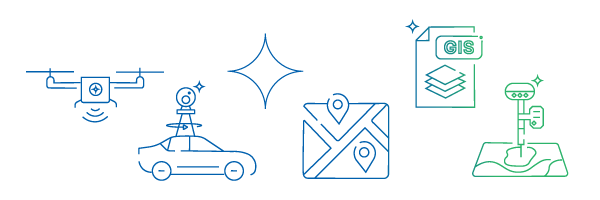In today’s world, data is becoming a crucial driver of governance in both the private and public sectors. In such a scenario, spatial data has gone beyond being a secondary asset. In this information-driven era, spatial data, when processed and deployed correctly, can inform data-driven policymaking, facilitate more efficient administration, and enhance public service delivery. When it comes to a country as geographically and demographically diverse as India, developing a robust Spatial Data Infrastructure will be an exciting opportunity to streamline governance and accelerate growth.
Mapex, with several decades of experience, has established itself as a leader in geospatial intelligence. Throughout our journey, we have worked with several government bodies and supplied customised SDI solutions. We aspire to leverage this technology and make it more accessible, leading our authorities to use actionable insights.
Understanding SDI: The Framework Behind Smarter Governance
Before we move forward, let’s break down what spatial data infrastructure involves. SDI is an integrated system of not just technologies but also standards, policies, and human resource that come together seamlessly to collect, share, and use spatial data. While some may assume it is a singular software or platform, it is a comprehensive ecosystem that helps the management of geospatial information across different sectors.
Here’s what a robust SDI would typically include:
- High-resolution satellite and aerial imagery
- Geo-referenced cadastral and utility data
- Metadata standards for data discovery and quality assurance
- Web-based platforms for data visualisation and access control
- Policies that promote interoperability, openness, and collaboration
While these components are useful on their own, they are still underutilised. By leveraging an SDI, authorities can plan more effectively and execute tasks more efficiently to better support citizens.
Understanding why India Needs SDI
Due to India’s three-pronged governance structure, which includes local bodies, state bodies, and central ministries, spatial data is dispersed across multiple agencies in formats that are seldom standardised. The data being fragmented in this manner can slow down planning, increase compliance, and impact accountability.
For instance, a metro rail project must account for land use maps, flood-prone zones, slum rehabilitation plans, and heritage building restrictions. If there is no shared spatial framework, every department will work in isolation. This process could lead to not only delays and cost overruns but also legal challenges.
The National Geospatial Policy, devised in 202,2 identifies this gap and has laid out a plan to build an integrated ecosystem. However, this is just a start. With agencies like Mapex, we will be able to bridge the gap between intent and impact.
How SDI Enables Government Collaboration
-
Integrated Planning Across Departments: SDI enables agencies, planners, engineers, and, most importantly, administrators from different departments to access all data simultaneously. Such data access helps accelerate decision-making and transparency.
-
Accelerated Project Approvals: With data-driven dashboards, SDI platforms help bring together building plans, environmental clearances, and land records. Geo-tagged validations and automated document checks helps reduce time taken for administrative approvals.
-
Enhanced Public Accountability: In a society like India, where land litigation is a long-drawn affair, SDI helps individuals verify land boundaries, access urban plans, and monitor project progress. This increased transparency builds trust and reduces scope for malpractice.
-
Improved Disaster Response: SDI can be particularly useful during disasters such as floods or earthquakes as the system enables real-time mapping of affected areas, evacuation zones, which reduces response times and simplifies provision of aid to those affected.
India’s Economic Stake in SDI
India stands to significantly gain from an economic standpoint by integrating SDI into its development plans. To illustrate this, a report by Geospatial World stated that the integration of spatial data could unlock an annual economic value of ₹2.78 lakh crore across logistics, agriculture, urban planning, and manufacturing.
In logistics, SDI helps plan more efficient routes, saving fuel and enhancing delivery accuracy. In agriculture, it supports better crop planning and water use. In real estate, it reduces land disputes and builds investor confidence through verified land records.
Proven Collaborations: How Mapex Is Powering Public Sector Transformation
Over the years, Mapex has worked closely with several government bodies to build and implement SDI-like systems. During this process, we have achieved several measurable outcomes. A few highlights include:
Bihar BOCW Welfare Board – Labour Cess Assessment
- Digitised 50,490 under-construction properties across 219 wards
- Increased cess revenue by 35 percent within three billing cycles
- Reduced administrative delays by 60 percent with automated workflows
- Achieved sub-0.5 metre spatial accuracy using DGPS field surveys
Directorate of Land Records & Surveys, Government of West Bengal – Digital Land Modernisation
- Geo-referenced 68,453 cadastral sheets across 42,302 villages
- Reduced litigation and boundary disputes with sub-metre accuracy
- Enabled seamless integration of land registration and mutation processes
- Achieved 100 percent QA/QC compliance with RMS error targets
Together, these examples not only highlight our capabilities when it comes to executing large-scale projects but also the benefits of adopting such systems to improve administration qualitatively and quantitatively.
Challenges in SDI Implementation in India
Despite its benefits, building SDI in India comes with challenges:
- Old Systems: Many departments still use outdated maps and software. Mapex helps by creating systems that work with old formats and support gradual upgrades.
- Privacy Concerns: Sharing land and personal data can raise privacy issues. Our platforms use secure access controls, encryption, and activity logs to keep data safe.
- No Common Standards: Different formats and map settings make data hard to share. We follow national and global standards to make everything compatible.
- Lack of Training: Officials often lack skills to use SDI tools. Mapex provides training, manuals, and support to help them use the system confidently.
- Limited Funding: Many SDI projects stop midway due to funding gaps. We assist clients in building strong project plans and funding models to ensure long-term success.
The Role of the Private Sector in SDI
Governments may lead the way, but innovation often comes from the private sector. Companies like Mapex bring in advanced tools like drone mapping and Ai-based analysis, helping public agencies adopt modern, efficient ways of working.
We go beyond offering basic tools. We design complete, tailored systems that blend spatial data, analytics, user tasks, and dashboards suited to each department’s needs. Our approach reduces reliance on foreign tech, meets India’s data localisation rules, and supports local languages for wider access.
The Road Ahead: Making SDI a National Asset
To realise the full promise of SDI, India must focus on the following areas:
-
Mandate Data Standards: All spatial data generated under government contracts must follow common standards to enable reuse.
-
Create a Unified National Portal: Existing platforms like NSDI should evolve into citizen- and department-friendly services with dynamic maps, analytics, and APIs.
-
Incentivise State-Led Innovation: States like Maharashtra, Karnataka, and Odisha have piloted SDI modules. A central fund to support custom implementations would encourage adoption.
-
Enable Real-Time Data Integration: Static maps are no longer sufficient. IoT, mobile apps, and drones can feed live spatial data into SDI platforms for more responsive governance.
-
Public-Private Collaboration Models: Procurement reforms and output-based funding models can bring private expertise into large-scale SDI rollouts.
Conclusion
When it comes to an accelerating economy like India, where every square metre of land holds strategic, economic, and social value, SDI can make a wealth of difference in improving trust, transparency, and other governance outcomes.
At Mapex, we are proud to play a pivotal role in shaping this future. Our solutions bridge the gap between policy and practice, intent and implementation. Through every project, we aim to create systems that are not only technically sound but also socially impactful.
India stands on the brink of a spatial revolution. With the right infrastructure, partnerships, and policy support, SDI can become the nervous system of a truly digital, collaborative governance model.





Share this Article :
Published at: 20-08-2025